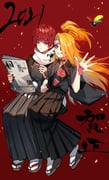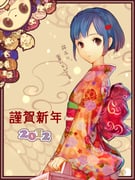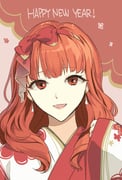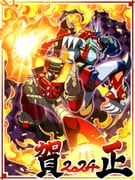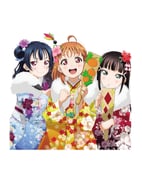new year
新年 正月 お正月 賀正 お正月イラスト HappyNewYear 大晦日 年賀絵
An image relating to the first day of the new year on the Gregorian calendar.
It's a tradition for many Japanese artists to celebrate the new year by drawing girls clad in expensive kimono, eating zouni soup, carrying hamaya (a Shinto ward against evil and bad luck) and playing hanetsuki.
Many artists also pay tribute to the Chinese zodiac by incorporating whatever animal corresponds to the year. It should be noted that the Chinese new year is not on January 1 of the Gregorian calendar, but instead varies from one year to the next (falling in either late January or early February). The year of the horse, for example, begins January 31, 2014. Despite this, images utilizing the animal of an upcoming Chinese New Year tend to begin appearing around January 1, as Japan uses the same zodiac but does not use the Chinese Lunar calendar.
The typical way of telling if an image is celebrating the New Year is by the phrase 謹賀新年 (kinga shinnen, literally "happy new year") or by one or both of the more traditional greeting exchanges (shortened as akeome and kotoyoro). It is also common for New Year images to include Happy New Year in English text, and/or the number of the year. Text indicating a new year related image may also be absent from the image itself but present in Pixiv tags/artist commentary, website text, etc.
List of Chinese zodiac years
- year of the rat
- year of the ox
- year of the tiger
- year of the rabbit
- year of the dragon
- year of the snake
- year of the horse
- year of the goat
- year of the monkey
- year of the rooster
- year of the dog
- year of the pig
See also
- akeome (New Year's greeting)
- kotoyoro (New Year's greeting)
- nengajou (Japanese New Year cards)
- kadomatsu (bamboo New Year's decoration)
- shimekazari (knitted rice straw rope)
- hanetsuki (badminton-like New Year's game)
- hatsumoude (first shrine visit of the New Year)
- hatsuyume (first dream of the New Year)
- happy new year
- kagami mochi (traditional New Year's dessert)
- otoshidama (gift of money given to children)
- ema (wooden prayer/wish board)
- omikuji (Shinto fortune slips)
- omamori (pouch-shaped amulets sold at shrines)
- chinese new year
- tag group:holidays and celebrations
- tag group:year tags
The following tags are aliased to this tag: new_years and newyear (learn more).
The following tags implicate this tag: hatsumoude, kotoyoro, and nengajou (learn more).

